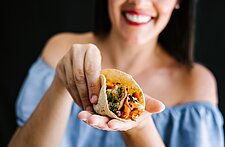Because Latinos comprise one of the fastest growing U.S. populations, food producers and marketers are scrambling to learn what makes them tick. In this post, we’ll take a look at what food means to Latinos, as well as what’s gracing their tables now. In the next three posts, we’ll get a little more specific as we cover Latinos and their preferences and behaviors with regard to meat, chewing gum, and coffee, three of the biggest food product markets in the U.S.
Food Is the Glue that Holds Families Together
Let’s start with what food means to Latinos, particularly Latino women, who are for the most part in charge of selecting, buying, and preparing food. For this group, food is the anchor, the foundation, the beating heart of the home. It’s comfort. It’s a touchstone, something reliable, safe, and good in a world that sometimes offers little of those things.
Most comforting of all is soup, especially soup made by Mom. Whether it’s the prelude to a meal or, as in the case of hearty stews, the meal itself, good soup is good living. And it’s a point of pride for Latinas, who gain a great deal of satisfaction from serving their families delicious, homemade food of all kinds.
As Acculturation Grows, so Does a Taste for Convenience
Though the pace of life in the twenty-first century often makes it difficult to maintain traditions like home-cooked, made-from-scratch food, it’s still seen as an ideal, and many Latinas strive to serve the kind of meals they remember from their own childhoods.
Often, time constraints for more acculturated Latinos lead to a sort of hybrid approach to food, one that takes advantage of frozen foods, boxed entrees and side dishes, and other conveniences, yet still insists on homemade meal components when possible. But even when obligations outside the home make cooking like Mom next to impossible, quality and authenticity are highly valued in convenient food choices that serve as substitutes.
Health Consciousness Is Rising
Led by Latinas, this group is increasingly concerned about health, fitness, and weight control. As a result, low-calorie and low-fat foods are becoming more popular, as are foods made with simple, natural ingredients. But these alternatives must still communicate the kind of quality and authenticity Latinos prefer, as well as blend well with traditional cooking and eating patterns.
Blending Modern Practices with Traditional Ways Appeals to Latinos
Food producers and retailers looking to connect with Latinos should understand the importance of family and of food as not only nourishment for the body but as a way to sustain and strengthen familial bonds and traditions. While time pressures lead Latinos to rely on convenient alternatives to home cooking, food producers who communicate quality, authenticity, and family values tend to appeal more to this market, as do efforts to reduce calories and fat without sacrificing taste or tradition.
In the next post in this series, we’ll take a look at Latinos and meat, a staple of many meals, both traditional and new.





